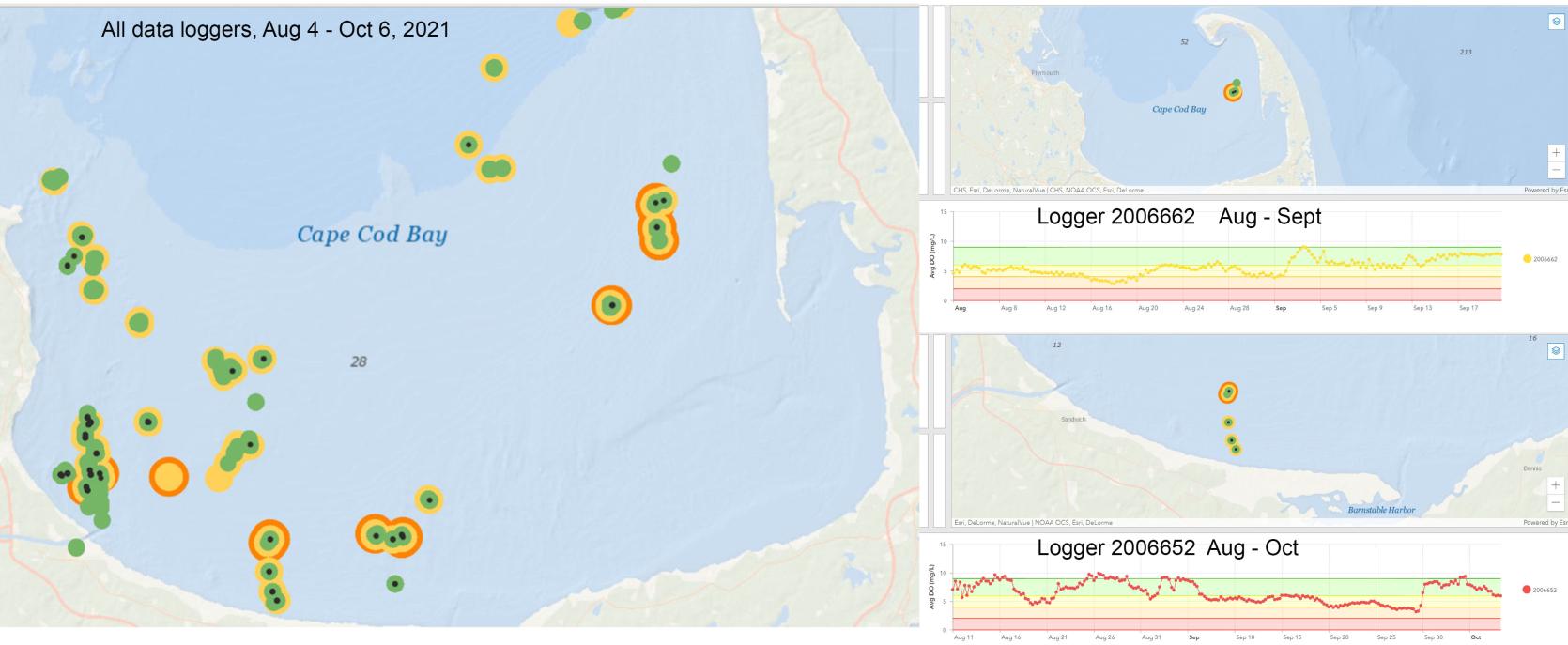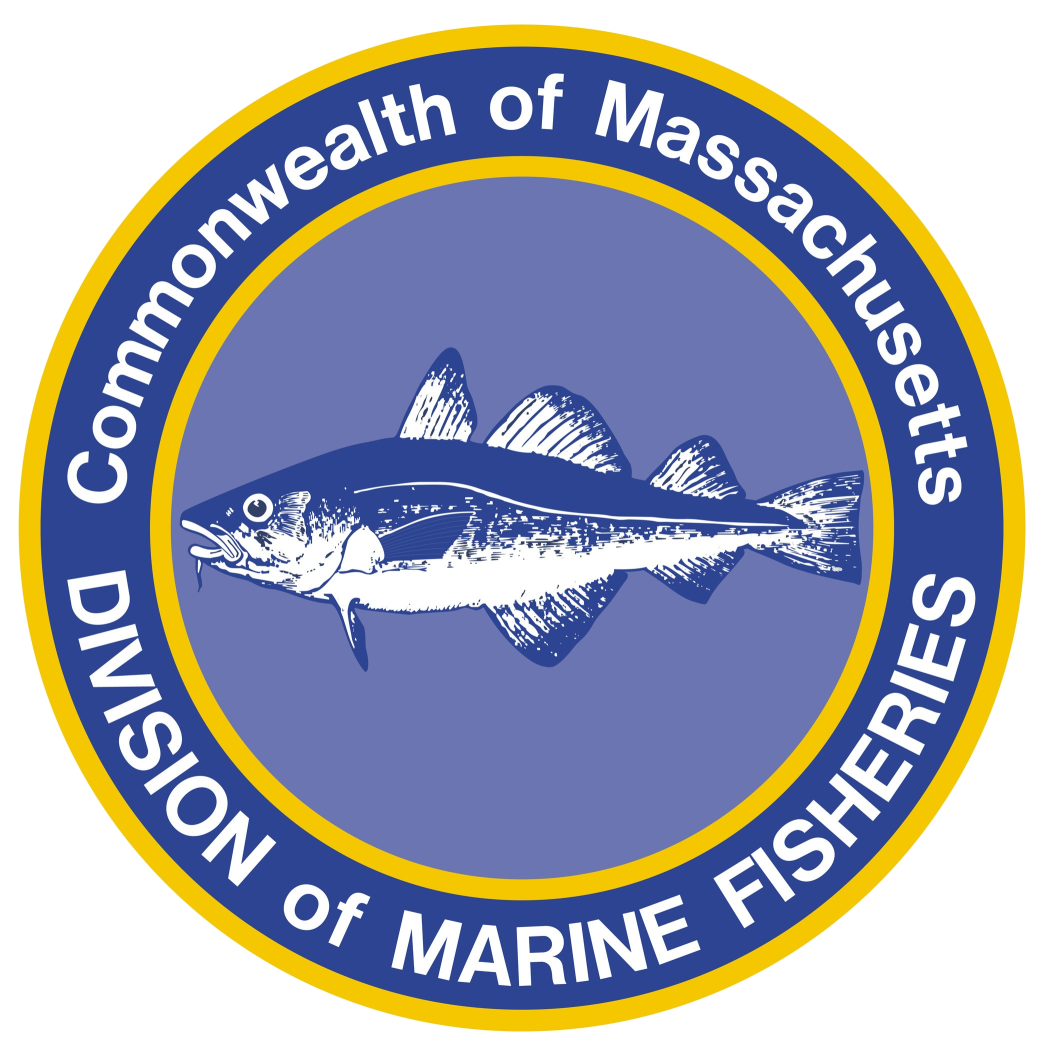- Division of Marine Fisheries

Researchers point towards a changing physical environment and the introduction of a new species of algae as the probable cause for the hypoxic conditions that developed in Cape Cod Bay in 2019 and 2020. Data collection continues with an eye towards predicting the occurrence of future hypoxic events.
Background: During late summer 2019 and 2020, bottom waters in southern Cape Cod Bay (CCB) became depleted of dissolved oxygen (DO). Bottom DO levels became severely hypoxic (<2mg/L) in water depths from 10 to 25 m (~30–80 ft) from west of the Cape Cod Canal east to Barnstable Harbor. In mid-September 2019, there were numerous reports of dead lobsters and scallops from the local fishing community indicating that DO levels had dropped to lethal levels in this region. In response to this unprecedented event, DMF began working with other scientists and the local lobster fleet to begin to understand what was driving hypoxia in southern CCB. As part of this effort the Massachusetts Lobster Foundation, in collaboration with DMF, created the Cape Cod Bay Study Fleet, which has provided oxygen probes to a number of lobster fishers in the region. These small probes are deployed in lobster pots and provide near real-time measurements of bottom DO. The goal of this program is to monitor bottom DO throughout CCB and alert the public when low DO conditions begin to develop.
2021 Season: In 2021, the Cape Cod Bay Study Fleet’s data loggers again detected hypoxia (see figure), but not the severely hypoxic conditions that occurred in the southern portion of the Bay in 2019 and 2020. The Fleet’s monitoring efforts detected declining DO levels in mid-August, earlier than the declines seen in 2020, which prompted concerns that 2021 might be another bad year. DMF issued an advisory to notify the commercial fleet and other stakeholders about these declining conditions, but fortunately conditions improved, apparently related to the passage of Tropical Storm Henri through the region on August 21–22. DO values declined again in September, but never reached severely hypoxic levels. Unlike previous years, some of the lowest DO values recorded in 2021 were to the north and east, near Wellfleet. Mild hypoxia was also observed in similar locations as previous years, in the area from Sandwich to Barnstable.
The Role of Environmental Changes: Even though severe hypoxia did not develop in 2021, understanding why these conditions have developed in recent years is important to managing the resources of this region. To that end, DMF is part of a team of researchers trying to understand how changing environmental conditions may be contributing to the emergence of hypoxia. DMF is collaborating with researchers from the Woods Hole Oceanographic Institution, the Center for Coastal Studies, and the Rhode Island Department of Environmental Management to collect and analyze data to better understand how changing physical and biological conditions in CCB are causing the unprecedented hypoxia observed in recent years.
Like the rest of the Gulf of Maine, water temperatures in CCB are increasing rapidly. However, bottom temperatures are not warming quite as fast as surface temperatures, which means that the late summer vertical temperature gradient is increasing. The presence of a strong vertical temperature gradient effectively isolates the cold bottom waters from the warmer oxygenated surface waters, cutting off the supply of DO and contributing to hypoxia. Wind patterns also appear to be changing—adding to the formation of a physical environment that may be more prone to depletion of oxygen from bottom waters than in the past.
These changes to the physical environment may also be leading to significant changes in the algal species that bloom in the water during late summer. Chlorophyll is an easily measured pigment that is used to detect and quantify blooms of small algal species known as phytoplankton. In late summer 2019 and 2020, chlorophyll levels were nearly three times higher than any previously documented year; with the highest concentrations occurring deep in the water column, at the interface between the cold bottom waters and the warmer surface waters (see figure). The unusually large blooms in summer 2019 and 2020 most likely provided excess organic matter that sank to the bottom and decomposed, utilizing nearly all of the bottom DO, which in partnership with the strong near-bottom temperature gradient, created the hypoxic conditions.
Why did such large blooms occur in 2019 and 2020? This is the key question that researchers are trying to answer. Algal cells take advantage of nutrients to grow and reproduce, and when there are a lot of nutrients available, growth and reproduction can be very rapid and result in a bloom. This normally happens in surface waters in the spring or early summer, when the algae can take advantage of lots of sunlight and nutrients that are available near the surface. Later in the summer and fall, when the water column becomes stratified (with warm, less dense water at the surface and cold, dense water near the bottom), surface waters become depleted in nutrients. Ample nutrients are available in the colder bottom waters, but there is often not enough light to support a bloom. However, that may be changing due to a combination of warmer waters, changing summer winds and a new species of algae.
In 2017, a species of dinoflagellate (a type of algae) named Karenia mikimotoi was detected for the first time in Massachusetts and Cape Cod Bays. Comprehensive monitoring in the region that began in the early 1990s never detected this species in any sample prior to 2017. However, after its initial detection that year, samples collected during summer 2019 and 2020 found very high levels of K. mikimotoi (more than 800,000 cells/liter). Unlike many of the species more commonly found in the bay, K. mikimotoi is adapted to low light conditions and can vertically migrate, allowing it to use the nutrient-rich bottom waters present during late summer. Routine monitoring conducted by the Center for Coastal Studies found that the anomalously large algal blooms in the summers of 2019 and 2020 were accompanied by anomalously low bottom nutrient levels, suggesting that prior to 2019 there were plenty of nutrients available in the bottom waters, but nothing was able to use them.
The coincidental emergence of K. mikimotoi and severe hypoxia in CCB is consistent with a rapidly changing environment. The research team hypothesizes that the changes to the physical environment in CCB have created conditions that K. mikimotoi is particularly well-suited to exploiting. Combined, these new physical and biological conditions are what the team thinks is causing the bottom waters in Cape Cod Bay to tip over the threshold from low DO to hypoxic levels, and in 2019 and 2020, severely hypoxic. The research team is in the process of presenting these results to the scientific community for review, and in the meantime will add the information collected this year to the larger dataset. Hopefully with the addition of the 2021 data we can begin to understand how year-to-year differences in these variables determine whether we tip the scales into severe hypoxia, getting us one step closer to our goal of being able to predict hypoxic events.
By Tracy Pugh, Ph.D., Invertebrate Fisheries Project Leader, and Malcolm Scully, Ph.D., Associate Scientist, Woods Hole Oceanographic Institution
